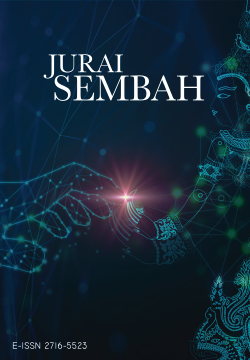Sustaining Mak Yong – Main Puteri in Raman: A Discussion of its Existence in Cultural Evolutionary Thread
DOI:
https://doi.org/10.37134/juraisembah.vol1.2.1.2020Keywords:
cultural evolution, dance theatre, mak yong, pattani, performing arts, traditionalAbstract
Mak Yong, a traditional Malay dance-theatre recognised by UNESCO as one of the intangible cultural heritage of Malaysia has indeed seen its progress since its revival in the 1970s by some of its prominent artists such as Khatijah Awang of the Sri Temenggung troupe fame. Sadly, although Mak Yong belongs to the region of Kelantan-Pattani of the Malay Peninsula, the art form has seen its greater decline in its southern Thailand counterpart. This could be as a result of the political climate aside from the inclination of the local towards Sunni Islamic values that forbid some of its ritualistic elements. This is apparent especially in the neighbouring state of Kelantan where Mak Yong has already been banned to be performed in public since the early 1990s unless it adheres to the Syariah law. However, in the context of the forms' existence in Pattani, despite its resilience towards the test of time, it has not gained as much attention compared to the Kelantan counterpart. Most extensive case studies in the past were based on the Kelantanese group (Sheppard, 1974; Yousof, 1976 & 1992; Nasuruddin, 1995). To extend our understanding of the study of Mak Yong of the Malay world, this paper aims to discuss the forms existence in Southern Thailand, particularly in the district of Raman, Yala Province. Special focus on its discussion will centre around the question of sustaining the tradition in the region through the relationship with Main Puteri, another ritualistic dance-theatre closely related to Mak Yong. Through the epistemological approach of Cultural Evolution, this paper intends to preliminarily explore the importance of this relationship in the bigger picture of Mak Yong as part of the cultural evolution in the Malay world. By identifying its natural phenomena, it is hoped that more exploration can be done in the future on the realm of Southeast Asian traditional performing arts.
Downloads
References
Aboo Backer, M. B., Manoharan, P. & Shafii, A. S. H. (2017). The mind, body, spirits, and soul in traditional healing: A perspective of Bageh. In Shafii, A. S. H., Abdullah, N. F. L. & Aboo Backer, M. B. (Eds.). locating the soul of healing performance in Malaysia. (pp 24-33). Penerbit Universiti Sains Malaysia.
Bentley, R. A., Hahn, M. W., & Shennan, S. J. (2004). Random drift and culture change. Proceedings of the Royal Society: Biological Sciences, 271(1547), 1443-1450. https://doi.org/10.1098/rspb.2004.2746
Cuisinier, J., (1936). Danses magiques de Kelantan. Institut D'Ethnologie.
Hardwick, P. A. (2009). Stories of the wind: The role of shamanistic healing in Kelantan, Malaysia (Publication No. 3386680) [Doctoral dissertation, Indiana University]. ProQuest Dissertations Publishing.
Mesoudi, A. (2011). Cultural Evolution: How Darwinian theory can explain human culture and synthesize the social sciences. The University of Chicago Press.
Mohamad, Z. (2012). Report: The Mak Yong spiritual dance heritage conference, performances, and workshops. Asian Theatre Journal, 29(2), 445-460. https://doi.org/10.1353/atj.2012.0050
Nasuruddin, M. G. (1995). The Malay dance. Dewan Bahasa dan Pustaka.
Phongphaiboon, S., Thanasuk, S. & Kawhkhao, P. (2000). Knocking rust off the dagger: A look at the way of life of the people of the lower south. The Thailand Research Fund.
Pudentia, MPSS. (2010). The revitalization of Mak Yong in the Malay world. Wacana, Journal of the Humanities of Indonesia, 12(1), 1-19.
Shafii, A. S. H. (2017). Management style of Kelantan Mak Yong. In Nasuruddin, M. G. (Ed. & Trans.). Mak Yong – Malaysian legacy world heritage. (pp. 271-291). The Department of National Heritage, Malaysia.
Shafii, A. S. H., Ishak, S. & Abdullah, N. F. L. (2017). The mystical gathering between the supernatural, physical and the nether world of Main Teri among the Malay Community. In Shafii, A. S. H., Abdullah, N. F. L. & Aboo Backer, M. B. (Eds.). Locating the soul of healing performance in Malaysia. (pp. 34-41). Penerbit Universiti Sains Malaysia.
Sheppard, M. (1974). Ma’Yong: The Malay dance drama. In Osman, M. T., (Ed.). Traditional drama and music of Southeast Asia (pp. 133-142). Dewan Bahasa dan Pustaka.
Sheppard, M. (1972). Taman indera: Malay decorative arts and pastimes. Oxford University Press.
Skeat, W. W. (1900). Malay magic. The Macmillan Company.
Yousof, G-S. (2014). Issues in traditional Malay culture. Patridge Publishing.
Yousof, G-S. (2004). Panggung inu: Essays on traditional Malay theatre. UniPress, The Centre for the Arts, National University of Singapore.
Yousof, G-S. (1992). Panggung semar: Aspects of Malay theatre. Tempo Publishing.
Yousof, G-S. (1976). The Kelantan Mak Yong dance theatre: A study of performance structure [Doctoral dissertation, University of Hawaii]. http://hdl.handle.net/10125/12168
Downloads
Published
Issue
Section
License
Copyright (c) 2020 Syafiq Faliq Alfan

This work is licensed under a Creative Commons Attribution 4.0 International License.



